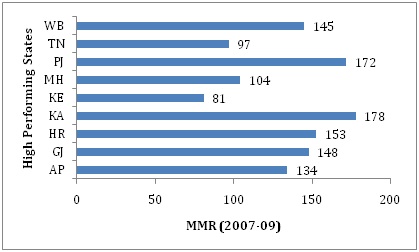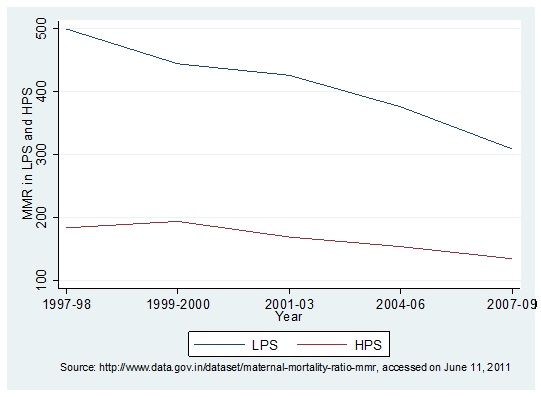
Trends in Maternal Mortality
26 June 2013
India has been one of the worst performers as far as maternal mortality is concerned. The Maternal Mortality Ratio (MMR), which measures the number of female deaths between ages 15-49 years , due to maternal causes per 1,00,000 live births, stood at 398 in 1997-98[1]. This figure came down to 212 for the period 2007-09, as per the latest Sample Registration System (SRS Bulletin, June 2011)[2]. Yet, this is nowhere close to the Millennium Development Goals (MDGs), which had set the target of MMR of 200 by 2007 and 109 by 2015. Unfortunately, the next round of SRS results has not yet been published and the latest MMR figures are not known[3].
This blog attempts to understand the trends in maternal mortality across the low and high performing States from 1997-98 to 2007-09 and assess whether the gap between the low and the high performing States has narrowed down during this period[4]. This is especially important given that the National Rural Health Mission (NRHM) has focused more on the low performing States.
Trends
These national numbers hide tremendous state-wide variation. MMR for the low performing States is much higher than the high performing States, and stood at 308 for the period 2007-09. The following table indicates state-wise MMRs for the low performing States.
Table 1: MMR in the Low Performing States (1997-98 to 2007-09)
| State | 1997-98 | 2007-09 |
| Assam | 568 | 390 |
| Bihar & Jharkhand | 531 | 261 |
| Madhya Pradesh & Chhattisgarh | 441 | 269 |
| Orissa | 346 | 258 |
| Rajasthan | 508 | 318 |
| Uttar Pradesh & Uttarakhand | 606 | 359 |
The table shows that even though the low performing States have seen a significant decline in MMR, their current levels indicate that they are unlikely to achieve MDG targets anytime soon. As far as the high performing States are concerned, only 3 States, Kerala, Maharashtra and Tamil Nadu have achieved the MDGs.
Figure 1: MMR in the High Performing States (2007-09)

Now, let’s see whether the gap between the low and high performing States has narrowed down in these 10 years.
Methodology
Consider the following regression:
Yit = β0 + β1 * LPSi + β2 * Yeart + β3 * (LPSi*Yeart) + εit
Where Yit = maternal mortality in State i in year t,
LPSi = dummy which takes value of 1 if the State belongs to the category of low performing States,
Yeart = indicates time-period. The baseline is 1997-98.
(LPSi*Yeart) = This is our variable of interest. A negative sign on the coefficient of this variable will indicate that the gap between the low and high performing States is narrowing.
Results
The following figure, based on the above regression, summarizes the results quite neatly. The top line is MMR for the low performing States, while the bottom line is MMR for the high performing States. The distance between the two lines represents the gap between these two groups.
The figure shows that, over a period of time, the gap between the two has declined. From more than 300 in 1997-98, it has come down to around 175. Can we say anything about the speed of decline in the gap? The figure indicates that the speed of decline has gathered momentum in the later years, more specifically, 2004-06 onward.
Figure 2: MMR in the Low and the High Performing States

What might explain this trend?
One explanation is the Janani Suraksha Yojana (JSY), which pays monetary incentives to women if they deliver in medical facilities. Assuming that better care is available in medical institutions compared to home, higher institutional deliveries should drive the maternal mortality down. There is an increasing evidence that the JSY has led to substantial increase in institutional deliveries (see here, here, and references therein). And hence, this is a plausible explanation[5].
Whether the JSY alone would help in achieving the MDGs, in the absence of adequate number of medical facilities, lack of infrastructure in these facilities, human resource deficit, absenteeism and abysmal quality of care remains to be seen[6].
[1] Deaths of women on account of pregnancy, childbirth or within 43 days of childbirth are regarded as ‘maternal’ deaths (SRS Bulletin, April 2000).
[2] All the figures used in this blog are sourced from various SRS bulletins available at http://censusindia.gov.in/vital_statistics/SRS_Bulletins/Bulletins.html
[3] This itself is quite surprising since the 2007-09 numbers were out in June 2011, exactly two years ago.
[4] As per the National Rural Health Mission (NRHM), the low performing States are Bihar, Jharkhand, Madhya Pradesh, Chhattisgarh, Orissa, Rajasthan, Uttar Pradesh, Uttarakhand, Assam and the states in the North-East India.
[5] Other potential explanations are rising incomes, better access to medical facilities, and increasing awareness levels about the benefits of institutional deliveries.
[6] Rural Health Statistics (2011), Concurrent Evaluation of NRHM (2009), Banerjee, A & E Duflo (2006), “Addressing Absence”, Journal of Economic Perspectives, 20(1): 117-132;Das, J & J Hammer (2007), “Money for nothing: The dire straits of medical practice in Delhi, India”, Journal of Development Economics, 83(1): 1-36





